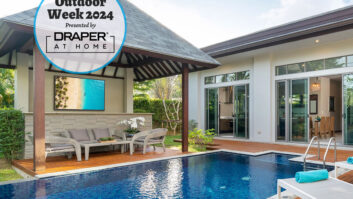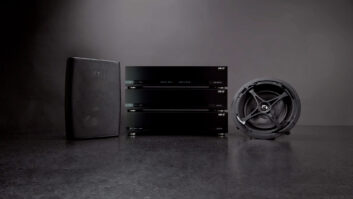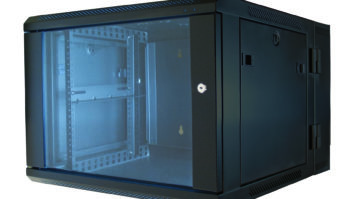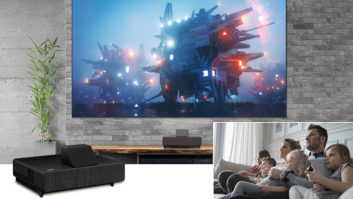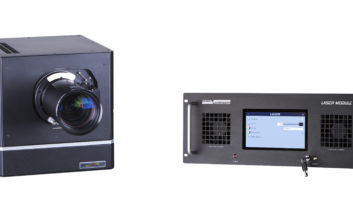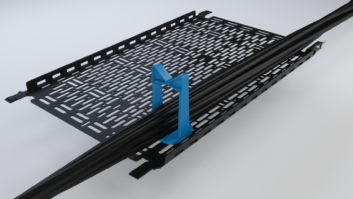While there are situations in which basic A/V systems are installed in very small enclosures and more elaborate systems find a home in large enclosures, most custom installations involve the mid-size cabinet. With some exceptions, the great majority of mid-size cabinet venting problems can be solved with just a few basic techniques.
For this article, mid-size describes a range of enclosures from 10-12 cubic feet (two feet wide by two feet deep by two and half feet high) to 30-35 cubic feet (four feet wide by two feet deep by four feet high). Construction is typically wood, whether the enclosure is a new cabinet built specifically to house home entertainment and home theater components, or an older piece of furniture designed for less technical purposes. In either case, the cabinet may have one or more shelves to hold equipment, while the wider ones may have both vertical dividers and shelves.
Installed in existing homes, these cabinets may simply be placed against a wall, exposing one or both sides. The back may be several inches from the closest wall, greatly facilitating ventilation. In newer homes, an alcove is frequently created in the family room into which an enclosure slides, or the enclosure is built-ina permanent part of the rooms structure. In these cases, one or both sides may not be available for powered or passive ventilation openings.
One feature common to stand-alone and built-in enclosures is the presence of a door, ensuring that the audio and video components inside the cabinet will have very little (meaning no) ventilation unless the designer or installer makes it happen.
While solving the technical issues of CFMs, BTUs, and dBs can be accomplished in a few minutes by telephone or e-mail, satisfying aesthetic considerations of mid-size enclosure cooling can be considerably more difficult and time-consuming. In almost all cases, by describing the damage that is being done to the clients expensive equipment when allowing it to overheat, compromises can be reached that will keep all parties, if not happy, at least cool. We have more than one A/V dealer who will not install a system unless the owner agrees that ventilation is essential and must be provided. Those dealers feel, with justification, that avoiding the nuisance service calls, shortened equipment life, and general dissatisfaction that overheating can cause is worth the extra sell up front.
The first thing a dealer should do is to specify fans that are designed for automatic cooling of A/V racks. Active Thermal Management, for one, has developed a group of fully automatic cooling products under the family name of System 2. This product will sense a temperature rise, turn on its fans slowly, and then gradually speed them up if the temperature continues to rise. When the equipment is turned off, the fans will gradually slow down as the equipment cools, turning off completely as the enclosure approaches room temperature.
After acquiring fans for your mid-size enclosure, the next step is finding the place where they work best. In general, the best solutions result in cool room air entering an enclosure at the bottom front, and heated air leaving at the top rear. Adding side air movement best cools wider enclosures; air should enter bottom front left (or right), and exit top rear right (or left). Complex, unobstructed air paths remove the most heat, and minimize the possibility of trapped pockets of stagnant air.
The simplest cases are cabinets whose backs are several inches from the closest wall. If theres one large compartment, put a fan blowing room air in, in a lower corner, and one blowing out in the diagonally opposite upper corner (see Figure 1). If there is more than one compartment to be cooled, either use four fans (two per compartment) or, for modest heat loads in two adjacent compartments, put an in-take fan in a lower corner, and one blowing out in the diagonally opposite upper corner in the other compartment. One large or several smaller openings in the divider between the compartments will allow the free passage of the air as it flows from the inlet to the exhaust point. Similarly, large (four-inch to five-inch diameter) openings in shelves allow the vertical passage of air. By making sizable openings in shelves directly beneath A/V components, the air will be directed at the component on the shelf. For this reason, it is best to have shelves run full depth in the cabinet, not cut short as is sometimes done to provide ventilation and facilitate cabling. Shortened shelves typically cause air to be routed up behind the component, cooling it inefficiently, if at all. It is better to make small openings or notches for wires, thereby forcing the air to go through large holes under the components. Any large openings that allow air to bypass the A/V components should be blocked, if possible.
If the cabinet back is up against an interior wall, it is frequently possible to cut through the wall and move cool air from (and heated air to) the room on the other side of the wall. (But not a garage, because fire codes generally prohibit openings between living spaces and garages.)
When installing a thermal management system there are a few things to keep in mind. First, do not expect air to move through fabric, no matter how open the weave. Slow-turning fans, used to minimize noise, dont have the power to force air through cloth, and, even if they could, the dust present in the air in the cleanest of houses would soon clog the weave, discoloring the cloth and stopping all airflow.
Second, use your imagination. By mixing and matching ideas posited here, you can almost always find a way to bring fresh air into a cabinet low, and preferably, in front. Similarly, a way can almost always be found to exhaust heated air high and, preferably, toward the rear of the cabinet.
Remember to make any openings that the air has to pass through as generous as possible. The goal is a free-breathing enclosure in which relatively large amounts of air can move slowly, noiselessly cooling the equipment within the cabinet.
In the case of an installation that consists of two equipment cabinets flanking a video display, the display (either CRT or flat-panel) is often located forward in a central cabinet, and has open space behind it. If the display is not sealed into the cabinet, you can often vent the component cabinets sideways into the space behind the display, allowing the air from the side cabinets to escape into the room from behind the display. Fresh air can be brought into each of the side cabinets using methods outlined earlier.
Frank Federman is president of Active Thermal Management (www.activethermal.com ) in Acton, California.
